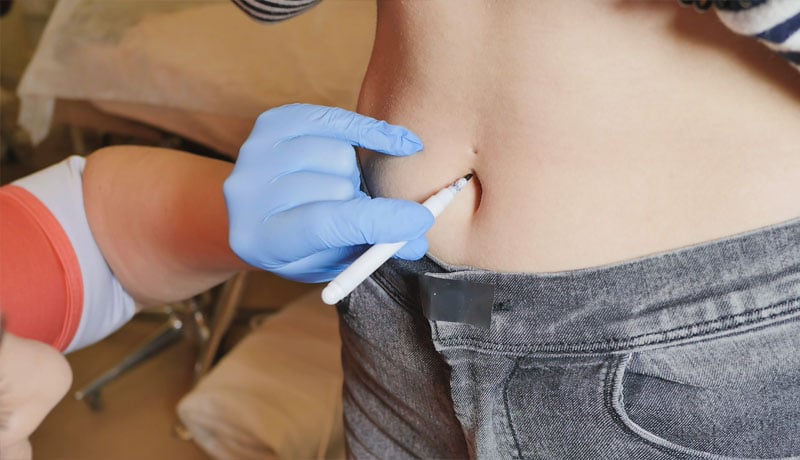
If you’ve ever read forums surrounding piercings, it should be clear that piercing pain is subjective. One piercing veteran might say that a certain piercing feels like nothing more than a tickle, and another might delve into a dramatic retelling of their piercing experience, including passing out, throwing up, and calling out to their mommies.
Regardless of your individual pain tolerance, when someone comes up to you with a thick needle and says, “I’m going to push this through your skin,” you’re going to feel a little anxiety.
The truth is that there will be some pain surrounding your piercing. The good news? There are ways that you can minimize that pain for a more enjoyable experience.
Note: Talk to your piercer before trying any at-home numbing methods. Many numbing methods affect blood flow and could do more harm than good, depending on the piercing.
‘90s kids will remember wincing as they watched a young Lindsay Lohan push a needle through her “twin’s” ear in The Parent Trap. Before the painful event, she used ice to numb the lobe before piercing.
Turns out, this isn’t just a Hollywood myth. Ice can numb the area for less pain during piercing. However, icing an area does restrict blood flow, and you can damage your skin if you leave the ice on for too long, so talk to your piercer before choosing this method.
Some recommend using a numbing cream prior to getting pierced. Be careful with this method; numbing creams contain chemicals that can irritate the skin, and you want to make sure that the cream is completely removed and that the piercing area is clean prior to piercing. After you’re pierced, do not use numbing creams on the new piercing. It will irritate the piercing and could cause infection, jewelry rejection, and scarring.
Most common, and most highly recommended, is to simply take an over-the-counter painkiller prior to being pierced. Typically, the mild medicine works well enough to alleviate any pain. Don’t take aspirin or other blood thinners, since your body will need to rush blood to the piercing area as part of the healing process, and blood thinners disrupt that essential process.
We’ve all been told to go to our happy places when we’ve been in positions of stress or anger. This isn’t just a playful piece of advice; meditation has been shown again and again to reduce stress, help with pain management, and bring us to a calmer, more enlightened state.
Why not use this to help with your piercing?

There’s actually a whole bunch of science behind why meditation works. The layman’s version is that your brain operates on different levels of brain waves, from hyperactivity to deep sleep. Meditation is the practice of controlling those brain waves. The slower the wavelengths, the calmer and more in control you feel. Once you reach a calmer state, your body will be less tense, and you’ll feel the stress of your piercing melting away.
Unless you’ve been practicing meditation for some time, you’re not going to be able to sit in the piercing chair and magically reach Nirvana. However, you can employ some meditation breathing tricks that can help calm you down.
These simple steps should help to calm you, or at the very least, distract you from the procedure.
Most of us have our coping mechanisms when it comes to stress. We have go-to games on our phone or that Spotify playlist that we blast in the car.
Distractions get a bad rap for their ability to keep us from the things that we’re supposed to be doing, but they do have a positive role in our lives. Often, half of the pain of a piercing is the fear of the imminent act. A common phrase you’ll hear fall from the mouths of the newly pierced is, “That wasn’t as bad as I thought it would be.”
Simply not thinking about what’s happening can greatly alleviate the pain and fear of the piercing. Bring along some music to focus on. Play Candy Crush on your phone. Bring your anything-that-connects-to-the-internet and zone out.
Friends can offer a perfect distraction as well as moral support. Turn it into a fun event by bringing your bestie. Their presence alone can have a huge effect on your entire piercing experience.
A lot of the piercing pain will depend upon your piercer. Expert, smooth motions will make the piercing process more bearable, not to mention the difference that their bedside manner can make.
Beyond ensuring that your piercer has the proper credentials to conduct a smooth piercing, you should find a piercer that you vibe with, especially if you’re nervous.
Decide what’s important to you in a piercer, and go out there and find the one with the perfect piercing personality for you. Don’t be afraid to shop around; piercers understand that getting a piercing is an intimate process, and they know what a big deal it can be. It’s important to find a piercer who will make your piercing experience a happy one.
“Bite the bullet” isn’t just a phrase you tell your friends when you’re trying to peer pressure them into a tequila shot. Dating back to the 1700s, patients that didn’t get any type of anesthetic were given a bullet to bite during their surgical procedure. Sure, that probably sucked pretty hard to gnaw on a metal piece of ammo, but it helped, and patients were able to survive the shock of some pretty nasty medical procedures.

“Bite the bullet” has become a war chant, a power phrase, and a perfect piece of advice when you get a new body piercing. Piercing pain lasts for mere seconds, and afterward, you have an awesome piercing to flaunt.
Clear your mind, don’t think, and just get it over with. It’s not as bad as you think it’s going to be.
Whether you decide to numb yourself, meditate and listen to Gregorian chants, mentally vacation to Bora Bora, jam to some tunes, play with your phone, or bite the bullet, just remember the end goal: an awesome piercing that you can enjoy for years to come.
The best part of getting pierced is filling your jewelry box with new body jewelry pieces. Once your piercing has fully healed, you’ll be able to decorate it to your heart’s desire. As you sit in the piercer’s chair, instead of thinking about the impending pain, think about the cute jewelry you’ll be able to wear in your new piercing in only a few months’ time.
Here’s some body jewelry inspiration to focus on while you’re in the piercer’s chair.
While you’re healing, you’ll have to wear the same piece of jewelry for a while. Why not make it a gorgeous one? Here are some beautiful 14k gold starter jewelry options.
2 Replies to “That Wasn’t So Bad: 5 Ways to Make a Piercing Less Painful”
Jimbo, 22 Jul 2019
When a man is getting either an apadravya or an ampallang piercing speaking from experience, I strongly recommend that the dude have a bite stick or a piece of leather, as a leather fob to bite upon. It aids. I’ve known dudes whom have literally cracked or chipped teeth. Also, some guys will use a towel to bite upon, also.
Anonymous, 20 Jan 2022
Hehe
I’ve had an apadrvya and it is more painful than a regular PA, at least for me. Truth be told, the pain was mostly my fault because I wasn’t fully prepared mentally. That can make all of the difference during the visit